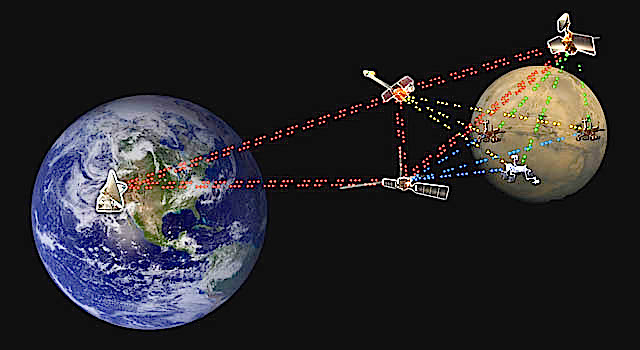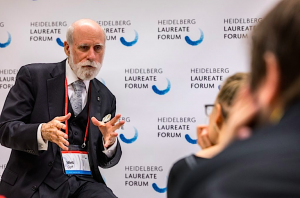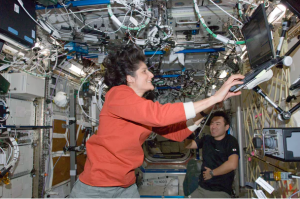 INFRA
INFRA
 INFRA
INFRA
 INFRA
INFRA
Where has NASA’s sense of adventure gone?
That’s what Internet pioneer and Google Chief Internet Evangelist Vint Cerf says he’s wondering these days. And you can hardly blame him. NASA support for his pet Interplanetary Internet project has been as spotty as Jupiter.
The set of extraterrestrial network protocols Cerf developed with NASA and its Jet Propulsion Laboratory, which are intended to provide speedier connections between Mission Control and its spaceships, orbiters, satellites and landers, isn’t getting the budgetary or standardization help it needs to get to the next level, he said. That’s despite a string of successful International Space Station and Goddard experiments over the last two decades,
“I’m frustrated that it has not had much higher priority at NASA,” he said in an interview. After all, “it is a tiny cost to finish standardization and implementation and it would create substantially more flexibility in mission design. I am dumbfounded that (the Interplanetary Internet) hasn’t had the priority it deserves.”
Cerf delivered an update on the Interplanetary Internet Friday at the 5th Heidelberg Laureate Forum in Germany. Cerf, a 2004 Turing Prize winner for his work with Bob Kahn on designing the TCP/IP protocol underlying the Internet back in the 1970s, is one of 25 winners of the Turing Prize, ACM Prize in Computing, Abel Prize, Field’s Medal and Nevanlinna Prize here to present to and rub elbows with a global cadre of 200 young researchers working in AI, robotics, virtual reality, materials science and other cutting-edge tech and math fields.
Frustrations aside, there’s a decent amount of new progress to report, Cerf said. For one thing, NASA now has officially crowned the Interplanetary Internet as a standard on board the International Space Station. That was a long time in coming.
Astronauts for NASA, the European Space Agency and the Japan Aerospace Exploration Agency, or JAXA, have been using it to simulate and actually accomplish real-time control of land-bound robots by orbiting space station astronauts. And the Interplanetary Internet’s protocols — Delay/Disruption Tolerant Network, or DTN, and Bundle Protocol, or BP — played a starring role in MIT’s and NASA Goddard Spaceflight Center’s laser optical network tests last year between Earth and a moon orbiter, which delivered data at the historic rate of 622 megabits per second.
Using the old point-to-point radio network NASA has relied on since 1958, it would take 639 hours to download a regular HD movie. But at the optical rate demonstrated in just the 2013 Lunar Atmosphere Dust Environment Explorer orbiter test, that download would take fewer than eight minutes, officials have said.
And how does that compare with Earthling times? Well, the typical speed of a U.S. Internet connection is about 12K mbps. To stream a Netflix movie decently, you need about 500 mbps and, of course, a continuous connection.
The tech, from Cerf’s perspective, isn’t the problem here. Rather, the culprit is bureaucracy.
“I’m feeling good we have a set of protocols that work,” Cerf said. “The Interplanetary Internet has really come a long way in terms of solidity recently.” He added that the nonprofit Mitre Corp., which manages a variety of federally funded research, recently took the meaningful step of publishing the source code on GitHub. What’s left is to standardize the entire Interplanetary Internet system that’s built on top of those protocols.
“We just have to convince NASA scientists that they are free to plan missions that aren’t supported by point-to-point radio links,” Cerf said. “We can increase the ambition factor dramatically just by providing them with a rich and adaptive communication system.”

Vint Cerf (Photo: Christian Flemming for Heidelberg Laureate Forum)
The point-to-point radio system Cerf hopes to free NASA scientists from is the Deep Space Network. It has been the way Mission Control and space craft have communicated since Elvis Presley was a young 20-something. These days, though, it’s an aging and sluggish, old-school point-to-point radio network comprising three giant 70-meter dishes and an assortment of smaller 35-meter dishes situated around the world. To repeat: It’s radio.
That might have been sufficient in NASA’s early decades, back when a limited number of space objects were out there — and “out there” meant no farther from the moon. The farther objects get from Earth — say, in farflung Mars orbits or farther — the slower that dinosaur network gets.
That’s the problem Cerf set out to solve back in 1998. As a co-creator of TCP/IP, he met with JPL engineers who thought perhaps a similar solution would work in space. At that first meeting, “we were literally finishing each other’s sentences,” he said.
In 2000, DARPA set up a team including Cerf to create such a system. “Our objective in designing the system was an architecture and a set of protocols that would support a full range of real time communication and deferred communications,” he said. “In addition, we also wanted it to enable spacecraft to be able to talk to each other … not to send messages all the way back to Earth to do it.
At first, it seemed like a basic TCP/IP design might be the ticket. But it quickly became clear that the huge distances of space and the fact that it prevents constant online connectivity would require something completely different.
“All of our thinking about network management when we (designed) the TCP protocols for the Internet were based on assumptions of relatively low delay and high reliability. But for the Interplanetary Internet we realized the issues were just the reverse: high delays and low reliability. So in the end we developed a whole new suite of protocols.”
Those included the DTN and BP protocols, which are store-and-forward networks like our terrestrial internet but configured to make up for the lack of constant connectivity in space and potentially long delays.
Like packets on the internet, bundles are forwarded from node to node, stored at each until a connection allows the bundle to be passed to toward it destination. It’s a network of nodes passing packets of information back and forth. But in this internet, millions of miles can separate the nodes, and its backbone can comprise old scientific orbiters repurposed to be data relay links.
The network’s first real success arrived in 2008 when a U.K. satellite used the BP protocol to send a beefy image file to an Earth destination. Later that year, NASA’s EPOXI comet surveillance craft, formerly known as Deep Impact, became the Interplanetary Internet’s first node.

Space station Expedition 33 commander Sunita Williams remotely drove a small LEGO robot at the European Space Operations Centre in Darmstadt, Germany, from on board the ISS, using NASA’s DTN to simulate how astronauts orbiting a planet might control a robot on the surface in real time. (Photo: ESA/NASA)
In 2012, NASA and the European Space Agency managed to remote control a rover made of Legos using DTN. ESA soon after used DTN to simulate control of a rover on the surface of Mars from astronauts working in its orbit. Then in 2015 when ESA and JAXA astronauts drove a 2,000-pound rover on the ground in Germany from within the actual ISS.
So why the foot-dragging?
“When we started, we had internal support — tolerance, really — at JPL,” Cerf said. Since 2000, however, “we have been inching along with only very modest support from different parts of NASA. At one point, in 2008 or 2009, DARPA … paid to demonstrate that BP was more effective than TCP for data transport in disrupted environments, for example, when signals were jammed or lost.”
One thing that may have slowed NASA’s funding commitment to the Interplanetary Internet is the 2005 cancellation of the Mars Telecommunications Orbiter. It was supposed to be configured as a permanent node and deep space relay link between rovers on the ground in Mars and Mission Control scientists on Earth. Its use of lasers, rather than radio, would have been a great showcase for DTN and its ultrafast transmissions.
Still, that doesn’t explain why NASA has been so slow. Cerf and others on the JPL team behind the DTN protocols have been quick to blame the caution of Mission scientists, who are notoriously reluctant to agree to anything that might jeopardize their budgets.
Still true? “Well, the mission planners usually resist doing anything new or risky — and they don’t want to pay for new developments especially in communications if they can avoid it — preferring to spend their money on (equipment like) sensors,” Cerf said.
He thinks NASA should treat BP as an infrastructure development associated with the renovation of the Deep Space Network, but that line of reasoning has not generated budget to proceed at the pace he would like. So he aims to keep demonstrating flight readiness of the DTN/BP software to the point that mission planners are comfortable specifying it. Not least, if he were in charge, he would request that spacecraft makers such as Boeing Co., Ball Corp. and Lockheed Martin Corp. make this an off-the-shelf option for space communications.
At 74, Cerf remains phenomenally busy with his work as a Google vice president and a busy calendar full of speaking engagements. Yet he remains deeply committed to the Interplanetary Internet and its long-term success as a going concern. And in the end he is — dare he say it? — hopeful.
“It means a lot. It has been a nearly 20-year odyssey,” he told me. And there’s another reason for his drive: Adrian Hooke, a founding member of the group, passed away unexpectedly. Cerf thinks the project’s success would be a way to remember his contributions.
Plus, said Cerf, he worked on the F-1 engines for the Apollo programs, and “the idea that I could participate in a lasting legacy in space is really beguiling.”
Gina Smith, Ph.D., is an award-winning tech journalist and the New York Times bestselling author of Steve Wozniak’s biography, “iWOZ: How I Invented the Personal Computer and Had Fun Doing It” (2006/2014, W.W. Norton) and “The Genomics Age: Why DNA Technology Changes Everything” (2005/2011, Amacom), a Barron’s Book of the Year. Follow Gina on Twitter @ginasmith888.
THANK YOU